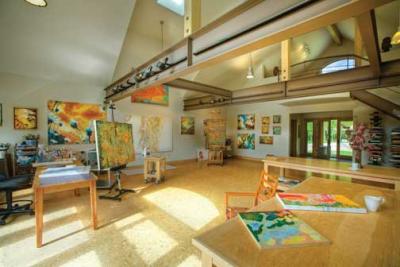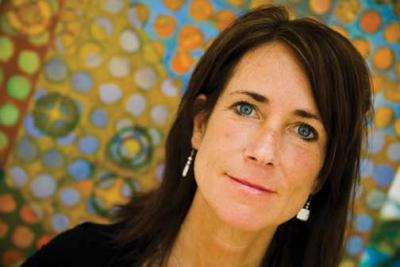Home Story: Art & Space
07/01/2008 01:00AM ● By Jennie Lay
Summer-Fall 2008:
Home Story: Art & Space
by Jennie Lay
Art & Space - In the studio with Diane Cionni Stellar Studio: Vaulted ceilings and ample light make paintings come to life in the Cionnis' art house downtown. Photography by Corey Kopischke It’s no wonder Diane Cionni’s paintings reflect spirituality and light. Her layers of sacred art, abstractions on nature and brilliant color are created in a space that is nothing less than divine. “People come in to look at my art and I have to give them 20 minutes to settle down because they are looking at the building,” Diane says, grinning as she glances around her studio. A devoted yogi since she was 16, she relaxes on a chair with one leg bound comfortably in half-lotus position. An unfinished canvas, inspired by meditation and her intricate studies of nature’s repetitive patterns, is propped on an easel nearby. For nearly five years, Diane and felloSteamboat Springs artist Susan Schiesser shared studio space in Strawberry Park. When the time came to find a nelease, Diane scoured Steamboat to no avail. “People tend to think artists want to work in garages,” she says. Finally, the empty downtown lot she and her husband – emergency room doctor David Cionni – had owned for 14 years came into play; but they knean eccentric studio wouldn’t fit the neighborhood feel of their home on Uncochief Circle. With the help of architect Joe Robbins, the art studio that Diane and David ultimately built is the first phase of a family home.
Stellar Studio: Vaulted ceilings and ample light make paintings come to life in the Cionnis' art house downtown. Photography by Corey Kopischke It’s no wonder Diane Cionni’s paintings reflect spirituality and light. Her layers of sacred art, abstractions on nature and brilliant color are created in a space that is nothing less than divine. “People come in to look at my art and I have to give them 20 minutes to settle down because they are looking at the building,” Diane says, grinning as she glances around her studio. A devoted yogi since she was 16, she relaxes on a chair with one leg bound comfortably in half-lotus position. An unfinished canvas, inspired by meditation and her intricate studies of nature’s repetitive patterns, is propped on an easel nearby. For nearly five years, Diane and felloSteamboat Springs artist Susan Schiesser shared studio space in Strawberry Park. When the time came to find a nelease, Diane scoured Steamboat to no avail. “People tend to think artists want to work in garages,” she says. Finally, the empty downtown lot she and her husband – emergency room doctor David Cionni – had owned for 14 years came into play; but they knean eccentric studio wouldn’t fit the neighborhood feel of their home on Uncochief Circle. With the help of architect Joe Robbins, the art studio that Diane and David ultimately built is the first phase of a family home.  Diane and husband, David, strike a pose. Outside, Diane’s studio appears a modest, mountain contemporary residence. Inside, it’s an oasis of creativity, a single serene, wide-open space with cool white walls, sustainable cork floors and appealing geometric windoarrangements. The fluid space fills with natural light and a sense of calm, and an ever changing installation of Diane’s working canvasses graces the towering walls. It’s designed with overhead beams and wall studs so someone else could eventually add windows, walls and extra plumbing to finish it out as a family home. But for now, this is safe harbor to delve into the treasure trove that inspires Diane’s art – an organized chaos of doodles and drawings, journal entries, electron microscope photographs of blood cells and liver disease, old sewing patterns, sacred art from India and Tibet, scraps of handmade paper, newspaper clippings and intimate manipulated photos of nature. Early in his progression toward contemporary design, this was Joe’s first art studio. It’s a “relatively compact, efficient design” he calls the “wave of the future.” While Diane was priced out of her aspirations for a completely self-sustainable structure, Joe says the 1,909-square-foot studio “is a greener building than she gives it credit,” with low-E glass, high insulation values, tight windows and doors, good use of natural cross-ventilation and a high-tech air exchange system for healthy indoor air quality. “I wanted to combine my yoga practice with my art, because that’s where my art was going,” Diane says. “I wanted it to feel like a little chapel, with the highest ceilings possible, something a little special.” A loft peers over her studio – a yoga and meditation space. In a typical day, Diane does an early morning pranayama meditation, paints, then an afternoon practice of asanas, or poses. “It’s the most perfect space for everything. All I have to do is walk in the door and I have a strong desire to work,” Diane says. Good lighting took top priority. The roof includestranslucent insulated panels that let in natural light – a feature that Diane fought hard to convince her builder, Hans Berend (harboring an understandable fear of notorious leaking skylights), to include. Her choice of industrial lights, hung as pendants from the giant beams that criss-cross the single-room expanse, were the result of consultations with Boulder-based museum lighting designer Steven Hefferan. Flying in the face of conventional wisdom, Diane wanted no south-facing windows. “It’s really bright and squirrelly light and it messes with your eyes,” she says. “North light is the artist’s light.” The single stationary element is a small kitchen – simple enough, with minimalist maple cabinets, a sink and iridescent glass tiles, not to be distracting. Everything else is moveable. Hans built her streamlined work tables with butcher-block-like tops – all on steel castors.
Diane and husband, David, strike a pose. Outside, Diane’s studio appears a modest, mountain contemporary residence. Inside, it’s an oasis of creativity, a single serene, wide-open space with cool white walls, sustainable cork floors and appealing geometric windoarrangements. The fluid space fills with natural light and a sense of calm, and an ever changing installation of Diane’s working canvasses graces the towering walls. It’s designed with overhead beams and wall studs so someone else could eventually add windows, walls and extra plumbing to finish it out as a family home. But for now, this is safe harbor to delve into the treasure trove that inspires Diane’s art – an organized chaos of doodles and drawings, journal entries, electron microscope photographs of blood cells and liver disease, old sewing patterns, sacred art from India and Tibet, scraps of handmade paper, newspaper clippings and intimate manipulated photos of nature. Early in his progression toward contemporary design, this was Joe’s first art studio. It’s a “relatively compact, efficient design” he calls the “wave of the future.” While Diane was priced out of her aspirations for a completely self-sustainable structure, Joe says the 1,909-square-foot studio “is a greener building than she gives it credit,” with low-E glass, high insulation values, tight windows and doors, good use of natural cross-ventilation and a high-tech air exchange system for healthy indoor air quality. “I wanted to combine my yoga practice with my art, because that’s where my art was going,” Diane says. “I wanted it to feel like a little chapel, with the highest ceilings possible, something a little special.” A loft peers over her studio – a yoga and meditation space. In a typical day, Diane does an early morning pranayama meditation, paints, then an afternoon practice of asanas, or poses. “It’s the most perfect space for everything. All I have to do is walk in the door and I have a strong desire to work,” Diane says. Good lighting took top priority. The roof includestranslucent insulated panels that let in natural light – a feature that Diane fought hard to convince her builder, Hans Berend (harboring an understandable fear of notorious leaking skylights), to include. Her choice of industrial lights, hung as pendants from the giant beams that criss-cross the single-room expanse, were the result of consultations with Boulder-based museum lighting designer Steven Hefferan. Flying in the face of conventional wisdom, Diane wanted no south-facing windows. “It’s really bright and squirrelly light and it messes with your eyes,” she says. “North light is the artist’s light.” The single stationary element is a small kitchen – simple enough, with minimalist maple cabinets, a sink and iridescent glass tiles, not to be distracting. Everything else is moveable. Hans built her streamlined work tables with butcher-block-like tops – all on steel castors.  Cionnified: Diane, self-proclaimed "neatnick" thought through every detail, right down to making sure the light in her home came from the north.Diane calls herself a “neatnick,” but an impeccable sense of space takes her studio beyond tidy and into a more intimate style of design. Here, everything finds its place. Tucked into a perfectly proportioned nook just inside the front door is a stunning long-necked ceramic vase boasting the crackles and the earthiness of its Raku firing. An intricately carved orb nestles atop the open neck. This is Diane’s death urn – a graceful reminder of her own impermanence each day – sculpted at her request by her son Jonah Skurky-Thomas, a successful ceramic artist. Its presence wraps the principles of yoga, a deep appreciation for fine art and an impeccable sense of space into a single package. “I love looking at it, knowing where I’m going to go,” Diane says.
Cionnified: Diane, self-proclaimed "neatnick" thought through every detail, right down to making sure the light in her home came from the north.Diane calls herself a “neatnick,” but an impeccable sense of space takes her studio beyond tidy and into a more intimate style of design. Here, everything finds its place. Tucked into a perfectly proportioned nook just inside the front door is a stunning long-necked ceramic vase boasting the crackles and the earthiness of its Raku firing. An intricately carved orb nestles atop the open neck. This is Diane’s death urn – a graceful reminder of her own impermanence each day – sculpted at her request by her son Jonah Skurky-Thomas, a successful ceramic artist. Its presence wraps the principles of yoga, a deep appreciation for fine art and an impeccable sense of space into a single package. “I love looking at it, knowing where I’m going to go,” Diane says.Check out Diane’s paintings at K. Saari
Gallery and online at dianecionni.30art.com. m



